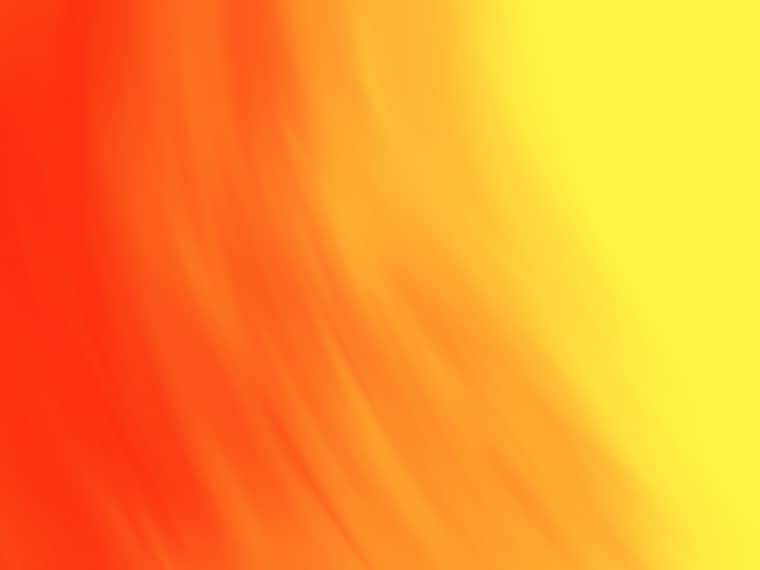Red and yellow are the colors that make us think of sunshine and warmth. Both colors are stimulating and are associated with strong emotions. But what color do red and yellow make when mixed?
Both yellow and red are warm colors. If you look at the color wheel, you will see that they represent the boundaries of warm colors. But what is the result of mixing red and yellow?
The result is a popular color that combines the optimism of yellow with the energy of red.
So what do you get if you mix red and yellow paints?
What Color Do Red and Yellow Make When Mixed?
When red and yellow colors are mixed, the color produced is orange. Orange is a secondary color obtained by mixing two primary colors (red and yellow).
There are many shades of orange, including well-known colors like amber, tangerine, salmon, coral, peach, and apricot.
Depending on the amount of red and yellow used in the mix, you can get different shades of orange.
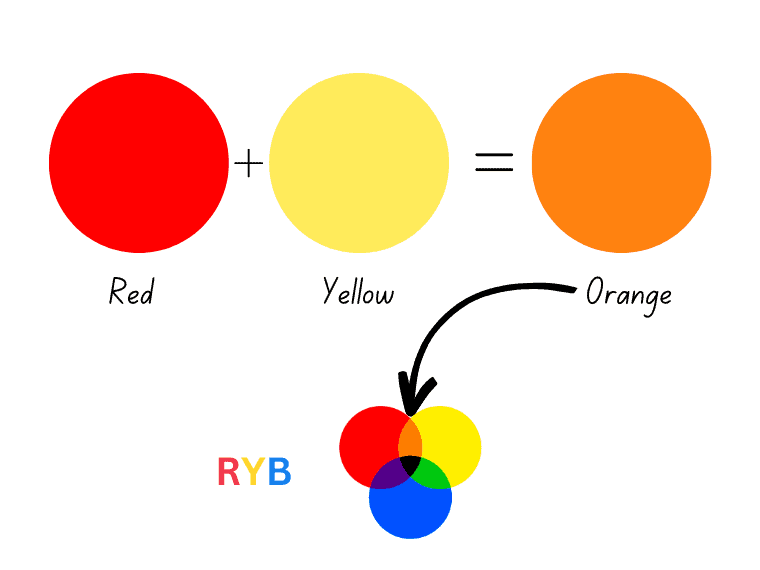
Why Do Yellow and Red Create Orange?
And the question on everyone’s mind is: what do yellow and red make? The answer, of course, is orange! But why do they make orange and not another color?
RYB, like CMY, is a subtractive color model.
When two colors are mixed in RYB or CMY, they subtract some colors and reflect others.
For example, when yellow and red pigments are mixed, the yellow pigment absorbs purple and reflects yellow and orange. In contrast, the red pigment absorbs green and reflects red and orange.
Ultimately, this mixture will only reflect the colors that have not been absorbed, producing orange.
Is it Difficult to Mix Orange Paint?
Even if it seems to be one of the simplest mixtures, the color obtained may differ from the expected result. For example, using an equal mix of yellow and red should result in a bright orange.
However, the colors used in the mix often do not have the desired purity. This is because almost every primary color carries a color bias.
Thus, you are likely to find colors with different color biases. For example, look at Alizarin Crimson and Cadmium Red. Alizarin crimson contains more blue, having a purplish tinge, in contrast to Cadmium red, which contains more red and is warmer.
Red can lean towards yellow and becomes a warm yellowish red. On the other hand, red can lean towards blue and becomes a cool bluish red.
Likewise, yellow can be a warm reddish yellow (red color bias) or a cool greenish yellow (green color bias).
According to color theory, mixing the primary colors yields the color brown. So let’s say a muddy brown.
So, if red has a slight hint of blue, you’ll likely get a muddy orange. So, you get the most beautiful orange by mixing yellow and red with as little hint of another color in them as possible.
How to Mix Shades and Tints of Orange
Every color has shades, tints, and tones. Orange seems to have more than any other color. So you can mix orange in a variety of ways. Thus, mixing red and orange can produce different shades.
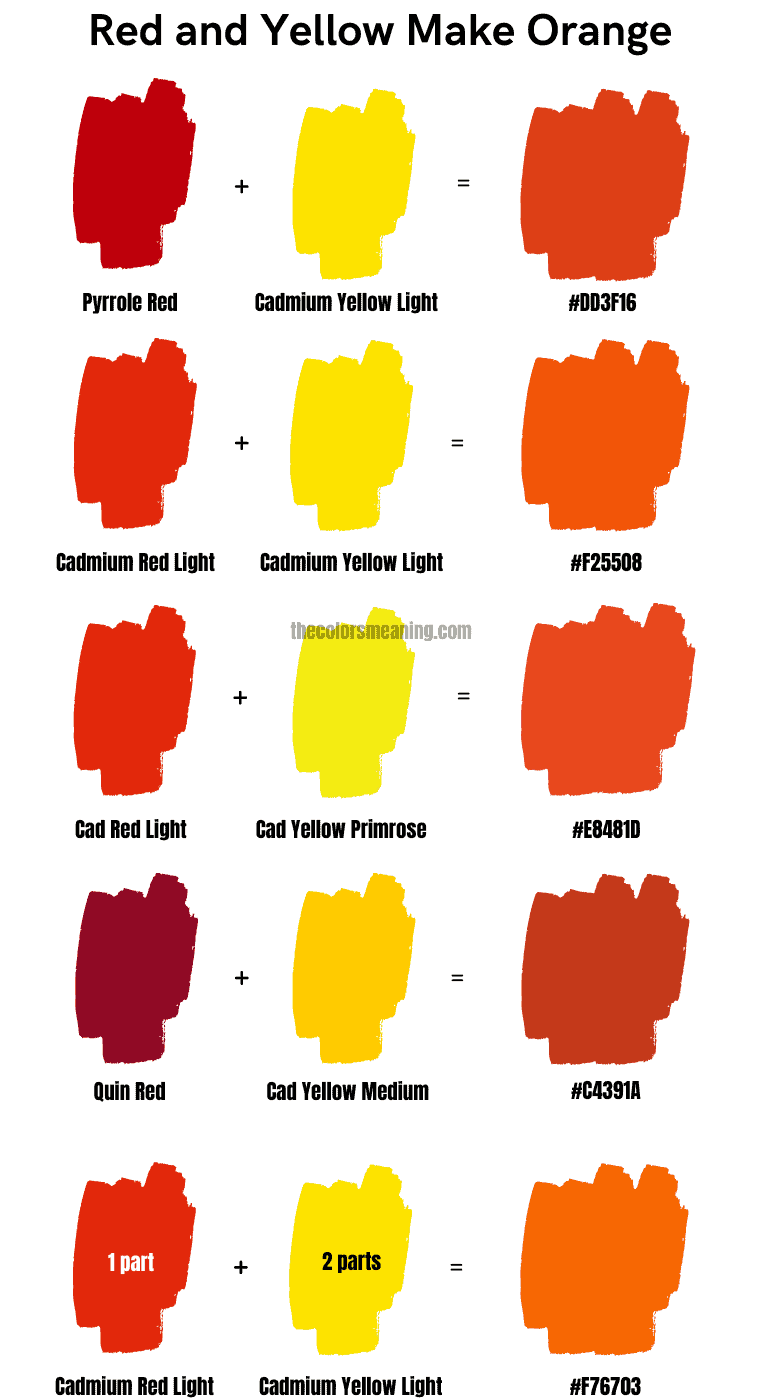
Mixing Light Orange
Adding white paint to your red-yellow mixture is the easiest way to create a light orange. However, the resulting color may lose its brightness. If you want to make a vibrant light orange, add more yellow paint.
Mixing Dark Orange
To create a dark orange, add some black paint. But be careful about the quantity, as it can easily overpower your final color due to its strength.
When mixing a dark orange, you can use dark shades of red instead of adding black.
By adding more yellow to the orange mixture, you will get a yellow-orange color. On the other hand, adding more red would intensify your orange, making it bolder.
Orange Meaning
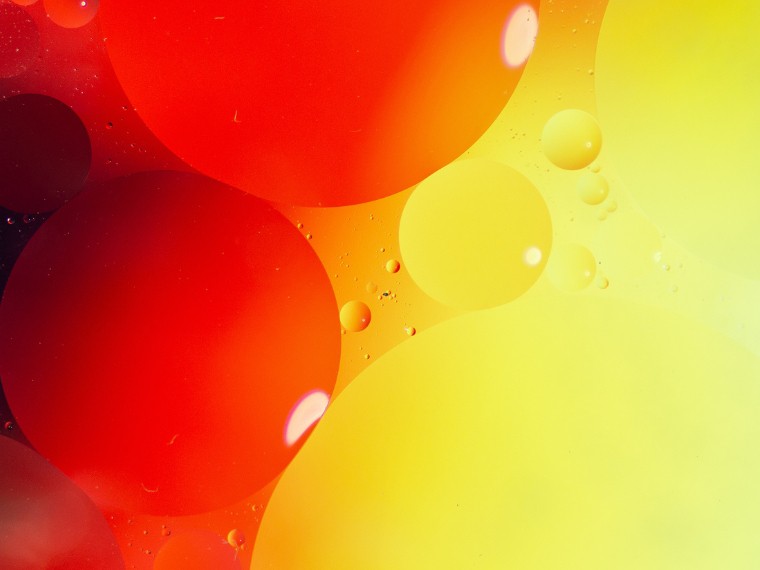
The color orange is associated with excitement, warmth, enthusiasm, and optimism. Moreover, orange is the color of youth and adventure.
It also combines the creativity of yellow with the energy of red. So orange motivates, encourages, and stimulates creativity.
On the other hand, orange can be associated with superficiality, impatience, and exhibitionism.
Interesting that the name of this color has not always been orange but rather yellow-red. Artists only started using the term “orange” associated with this color in the 16th century, when orange trees were brought to Europe.
So the popular fruit is the origin of the color’s name. However, there are many orange things in nature.
Can You Mix Colors to Make Red and Yellow?
Both red and yellow are primary colors on the RYB color wheel. This means they cannot be created by mixing other colors.
However, when it comes to red, we have a solution.
Red can be made by mixing magenta and yellow – two primary colors of the CMYK color space. This one is a subtractive color model.
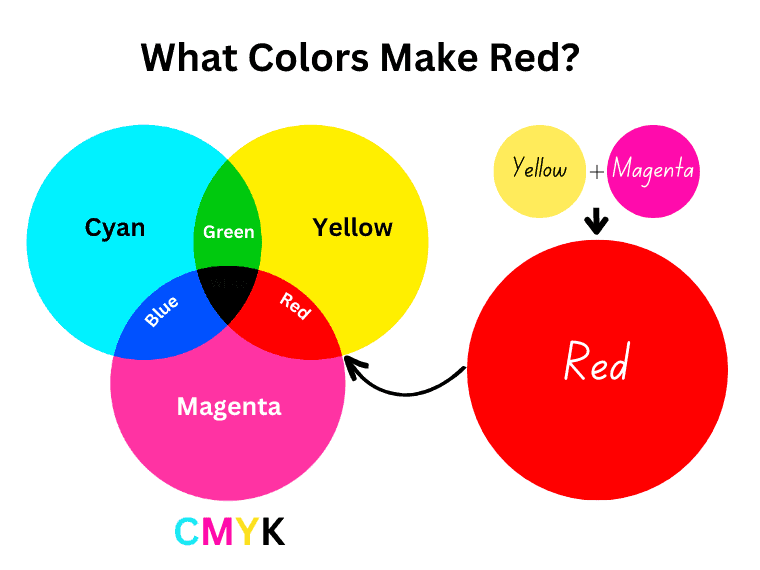
CMYK uses cyan, magenta, and yellow as primary colors. Additionally, it uses black to streamline the printing process and increase darkness. This type of color mixing is used in the printing industry.
What Color Do Red and Yellow Make in Lights?
In RGB space, red is a primary color, while yellow is a secondary color. So what do you get if you mix red and yellow lights? It’s no secret and the result of this mix yields orange.
Orange is a tertiary color in the RGB color space, unlike the RYB.
RGB versus RYB
RGB is an additive color model used for mixing light, while RYB is a subtractive color model used for mixing pigments and paints.
While RGB uses red, green, and blue as primaries, RYB uses red, yellow, and blue.
Furthermore, the RGB model is used in everything that emits light, including monitors, tablets, smartphones, and TVs. On the other hand, RYB is a traditional color model used in art.
How is Orange Perceived by Our Eyes?
When we look at an object, the color our eye perceives is determined by the light that is reflected or absorbed by that object.
When light hits an object, some colors in the spectrum are absorbed, and others are reflected back to our eye. Thus, what we ‘see’ is determined by the colors, or more technically, by the wavelengths that are reflected back to our eye.
In the case of pigments, color depends on how they reflect or absorb light. Pigments absorb certain colors of the spectrum and reflect others.
The wavelengths that a pigment reflects back to our eyes are what determine the color we see when we look at it.
For example, why do we see oranges, mandarins, and tangerines as orange? The answer is simple: because of the pigments they contain in their peel and the way they interact with light.
Mandarins contain carotenoid pigments in their skin that selectively absorb certain colors of light and reflect others.
The pigments in the skin of mandarins absorb some of the wavelengths of blue and green light while reflecting the longer wavelengths of red and orange light.
When these reflected wavelengths of light enter our eyes, they are detected by two types of cells in the retina.
These cells are photoreceptors of two types: cones and rods. While rods are very sensitive to light, cones specialize in visual acuity. [1]
As a result, we perceive the color as orange thanks to the information that these transmit to the brain.
What Color Do Yellow and Red Make with Ink?
Unlike traditional art, the printing industry uses the CMYK system. It uses cyan, magenta, and yellow as primaries. The “K” in the acronym stands for black. That’s because using black is easier and cheaper than making it from scratch.
In CMYK, yellow is a primary color, while red is a secondary color, resulting from mixing magenta and yellow.
So what does yellow and red make in CMYK? This ink mixture produces orange, as do paints and lights.
However, if you look at the CMYK composition of the orange shades, you will see that the red in the composition is actually a mix of magenta and yellow.
This means that most orange shades in the CMYK model are composed of magenta and yellow, with the addition of black for darker shades.
Let’s look at how different orange colors are created in the CMYK color space.
| Orange Shade | Type of Orange | CMYK Composition |
|---|---|---|
| Tomato | 61.2% magenta, 72.2% yellow | |
| Pumpkin | 51.8% magenta, 89.4% yellow, 3.9% black | |
| Yellow-Orange | 34.1% magenta, 78.8% yellow | |
| Princeton | 43.9% magenta, 100% yellow | |
| Burnt Orange | 58.3% magenta, 100% yellow, 20% black | |
| Salmon Orange | 49.8% magenta, 60% yellow | |
| Pure Orange | 49.8% magenta, 100% yellow | |
| Burnt Sienna | 50.2% magenta, 65.2% yellow, 8.6% black | |
| Coral | 50.2% magenta, 68.6% yellow | |
| Amber | 25.1% magenta, 100% yellow |
Did you notice that? In CMYK, red is made from magenta and yellow, and different shades of orange are created by mixing magenta and yellow in a 1:2 ratio. This is made up of two parts yellow and one part magenta.
CMY versus RYB
In the CMY color model, cyan is in the 4 o’clock position, and yellow is in the 8 o’clock position. This forms a triangle of the cyan, magenta, and yellow primary colors.
In the RYB color model, the primary colors of red, yellow, and blue occupy the same positions as cyan, magenta, and yellow in the CMYK.
Both CMY and RYB are subtractive color models. However, CMY achieves a larger gamut of colors, unlike traditional RYB, which instead produces a warmer gamut.
Do Red and Yellow Always Create Orange?
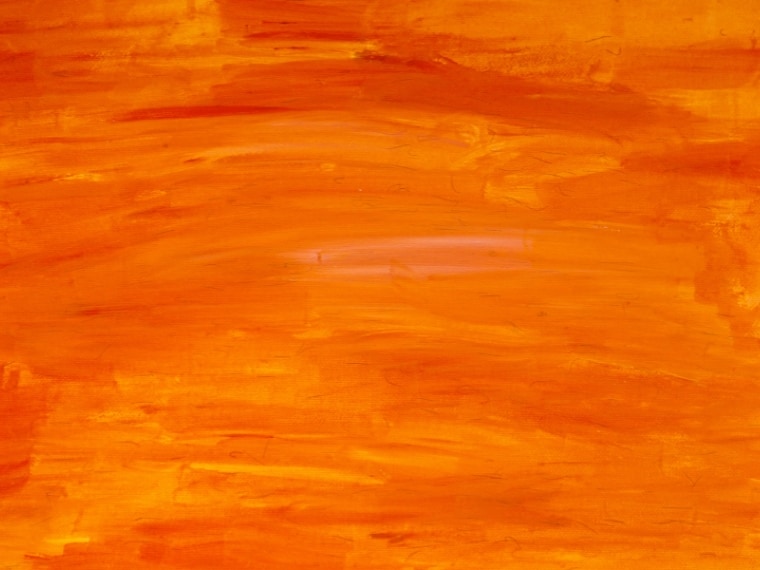
Yes, yellow and orange create orange, no matter what medium you’re using. Although it seems normal, the same mix in the three mediums (RYB, CMY, and RGB) often produces different colors.
For example, in painting, mixing green and red makes brown. In RGB, on the other hand, the same mix makes yellow.
This is because subtractive mixing differs from additive mixing. In additive (RGB), colors add together. Thus, its gamut is produced by adding light.
On the other hand, in subtractive mixing, colors are produced by subtracting or absorbing light from pigments.
In addition, the RGB model is an additive color model, which means that the more light we add, the brighter the color will be. On the other hand, the RYB model is a subtractive color model, which means that the more pigment we add, the darker the resulting color becomes.
Final Thoughts on the Color Produced by Mixing Red and Yellow
What color does yellow and red make? Here’s the answer: red and yellow make orange, the color of optimism, enthusiasm, and warmth. In addition, orange is a secondary color on the RYB color wheel.
Moreover, it has a lot of color meanings, including optimism, energy, spontaneity, and enthusiasm.
In design, orange attracts attention without being as loud as red or as bright as yellow. As a result, it’s often thought to be more welcoming and friendly.
Did you enjoy this post about what color do yellow and red make when mixed? Share it with your friends who may be interested.

